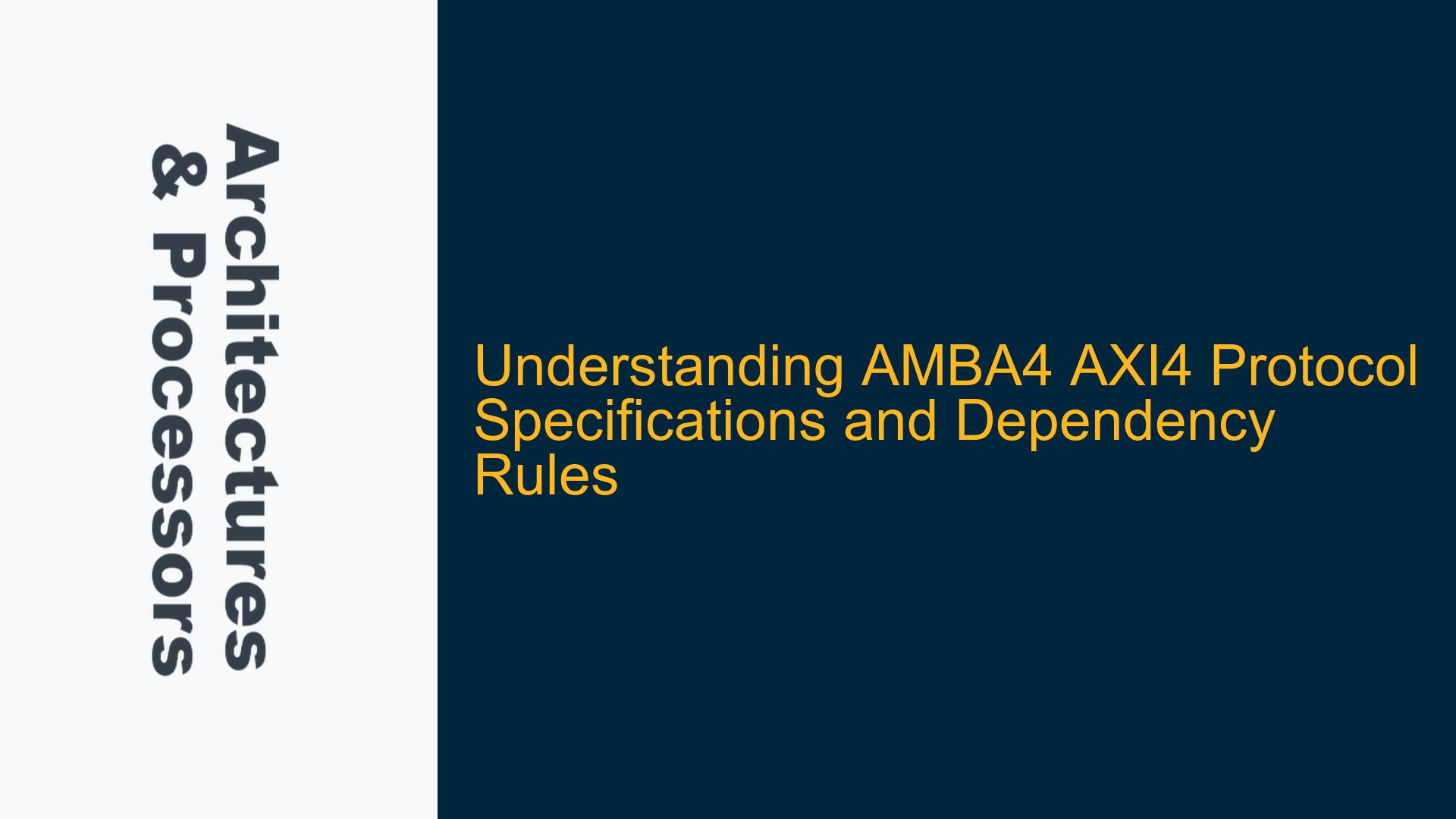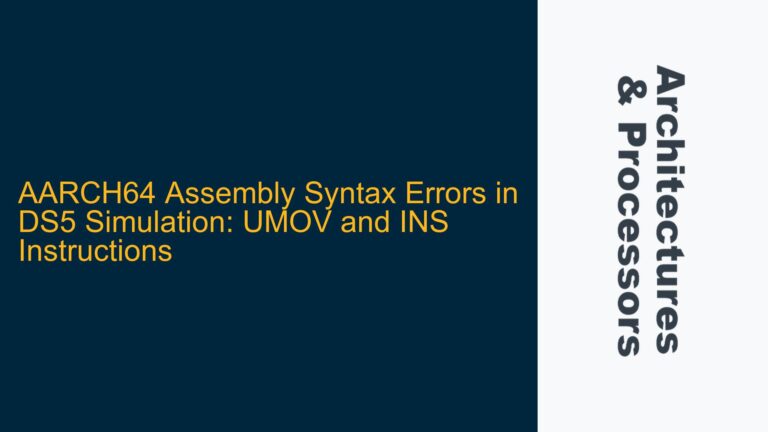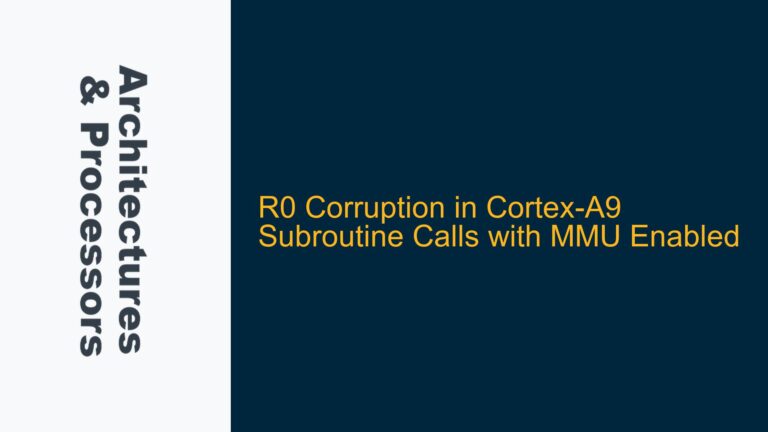AMBA4 AXI4 Protocol Specification Version E vs. AMBA5 AXI5 Protocol Specification Version K
The AMBA4 AXI4 Protocol Specification, specifically version E, is a critical document for understanding the AXI4 protocol, which is widely used in ARM-based SoC designs. However, the introduction of AMBA5 and its AXI5 Protocol Specification version K has introduced additional clarifications and requirements that were not explicitly stated in the earlier AXI4 specification. One such clarification is the dependency rule described in chapter A3.4 of the AXI5 specification, which states that requests sent by a master must not depend on other requests sent by the same master. This rule is not explicitly mentioned in the AXI4 version E document, leading to confusion about whether AXI4 designs must comply with this restriction.
The AMBA4 AXI4 Protocol Specification version E provides a comprehensive description of the AXI4 protocol, including the five independent channels (read address, read data, write address, write data, and write response), the signaling requirements, and the transaction ordering rules. However, it does not explicitly address the issue of transaction dependencies within a single master. This omission can lead to design ambiguities, particularly in complex SoC designs where multiple masters and slaves interact through an AXI interconnect.
In contrast, the AMBA5 AXI5 Protocol Specification version K introduces a more detailed set of guidelines, including the dependency rule in chapter A3.4. This rule is intended to prevent scenarios where a master’s transaction is delayed due to dependencies on other transactions from the same master, which can negatively impact system performance. While this rule is not explicitly stated in the AXI4 specification, it is generally considered good design practice to avoid such dependencies in AXI4 designs as well.
Dependency Rule in AXI5 and Its Implications for AXI4 Designs
The dependency rule in the AXI5 Protocol Specification version K states that a master must not send a request that depends on another request from the same master. This rule is designed to ensure that transactions on the AXI bus are as independent as possible, minimizing delays and improving overall system performance. The rule is particularly important in systems with multiple masters, where dependencies between transactions from the same master can lead to contention and reduced throughput.
In the context of AXI4, the absence of an explicit dependency rule does not mean that such dependencies are allowed. In fact, the AXI4 protocol implicitly assumes that transactions from a single master are independent, as this is a fundamental requirement for maintaining the performance and scalability of the AXI bus. However, the lack of an explicit rule in the AXI4 specification can lead to misunderstandings and design errors, particularly for engineers who are new to the AXI protocol.
The dependency rule in AXI5 can be seen as a formalization of best practices that have been followed by experienced AXI designers for years. By explicitly stating this rule, the AXI5 specification provides clearer guidance for designers and helps to avoid potential pitfalls in AXI4 designs. Therefore, even when working with AXI4, it is advisable to adhere to the dependency rule as described in the AXI5 specification.
Implementing Dependency-Free Transactions in AXI4 Designs
To ensure compliance with the dependency rule in AXI4 designs, it is important to carefully manage the transaction flow within each master. This involves ensuring that each transaction is independent of other transactions from the same master, both in terms of data dependencies and control flow. One common approach to achieving this is to use a transaction queue within the master, where each transaction is queued and issued independently of other transactions.
In addition to managing the transaction flow, it is also important to consider the impact of transaction dependencies on the AXI interconnect. In a system with multiple masters, dependencies between transactions from the same master can lead to contention at the interconnect, reducing overall system performance. To avoid this, designers should ensure that the AXI interconnect is configured to handle the expected transaction load, with sufficient bandwidth and arbitration mechanisms to prevent bottlenecks.
Another important consideration is the use of AXI4 features such as out-of-order transaction completion and multiple outstanding transactions. These features can help to improve system performance by allowing the AXI interconnect to reorder transactions and process them in parallel. However, they also require careful management to ensure that transaction dependencies do not lead to deadlock or other issues. By following the dependency rule and carefully managing the transaction flow, designers can ensure that their AXI4 designs are both compliant with the protocol and optimized for performance.
In summary, while the AMBA4 AXI4 Protocol Specification version E does not explicitly state the dependency rule described in the AXI5 specification, it is generally advisable to follow this rule in AXI4 designs. By ensuring that transactions from a single master are independent, designers can avoid potential performance issues and ensure that their designs are compatible with both AXI4 and AXI5. This approach not only improves the robustness of the design but also facilitates future upgrades to AXI5 or other advanced protocols.
Detailed Comparison of AXI4 and AXI5 Dependency Rules
To further understand the implications of the dependency rule in AXI5 and its relevance to AXI4, it is useful to compare the two protocols in detail. The following table provides a side-by-side comparison of the key aspects of the dependency rule in AXI4 and AXI5:
| Aspect | AXI4 Protocol Specification Version E | AXI5 Protocol Specification Version K |
|---|---|---|
| Explicit Dependency Rule | Not explicitly stated | Explicitly stated in chapter A3.4 |
| Transaction Independence | Implicitly assumed | Explicitly required |
| Impact on Performance | Potential for performance degradation | Improved performance through independence |
| Design Best Practices | Dependency avoidance recommended | Dependency avoidance mandated |
| Compatibility with AXI5 | May require modifications | Fully compatible |
As the table shows, the AXI5 specification provides a clearer and more explicit set of guidelines for managing transaction dependencies, which can help to improve system performance and avoid potential issues. While the AXI4 specification does not explicitly state the dependency rule, it is generally advisable to follow the same best practices in AXI4 designs to ensure compatibility and performance.
Practical Steps for Ensuring Dependency-Free Transactions in AXI4
To implement dependency-free transactions in AXI4 designs, designers should follow a series of practical steps:
-
Transaction Queue Management: Implement a transaction queue within each master to ensure that transactions are issued independently. This queue should be designed to handle the expected transaction load and should include mechanisms for prioritizing transactions based on system requirements.
-
Interconnect Configuration: Configure the AXI interconnect to handle the expected transaction load, with sufficient bandwidth and arbitration mechanisms to prevent contention. This may involve tuning the interconnect parameters, such as the number of outstanding transactions and the arbitration scheme, to match the specific requirements of the design.
-
Out-of-Order Transaction Handling: Utilize AXI4 features such as out-of-order transaction completion and multiple outstanding transactions to improve system performance. However, ensure that these features are managed carefully to avoid deadlock or other issues related to transaction dependencies.
-
Verification and Testing: Perform thorough verification and testing of the AXI4 design to ensure that transaction dependencies are managed correctly. This may involve using simulation tools to model the AXI bus and verify that transactions are issued and completed independently.
-
Documentation and Compliance: Document the design decisions related to transaction dependencies and ensure that the design complies with both AXI4 and AXI5 specifications. This documentation should include details on how the transaction queue is managed, how the interconnect is configured, and how out-of-order transactions are handled.
By following these steps, designers can ensure that their AXI4 designs are both compliant with the protocol and optimized for performance. This approach not only improves the robustness of the design but also facilitates future upgrades to AXI5 or other advanced protocols.
Conclusion
The AMBA4 AXI4 Protocol Specification version E provides a comprehensive description of the AXI4 protocol, but it does not explicitly address the issue of transaction dependencies within a single master. The introduction of the dependency rule in the AMBA5 AXI5 Protocol Specification version K provides clearer guidance for designers and helps to avoid potential pitfalls in AXI4 designs. By following the dependency rule and carefully managing the transaction flow, designers can ensure that their AXI4 designs are both compliant with the protocol and optimized for performance. This approach not only improves the robustness of the design but also facilitates future upgrades to AXI5 or other advanced protocols.






